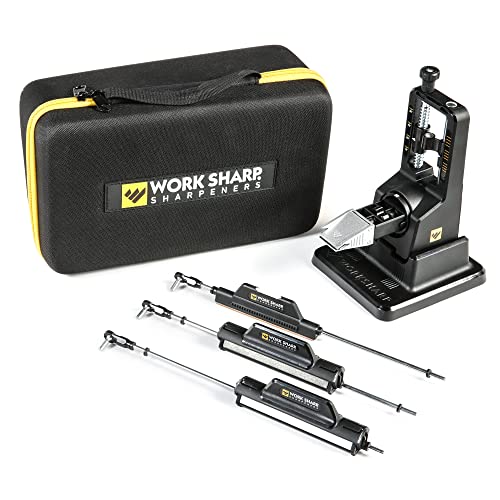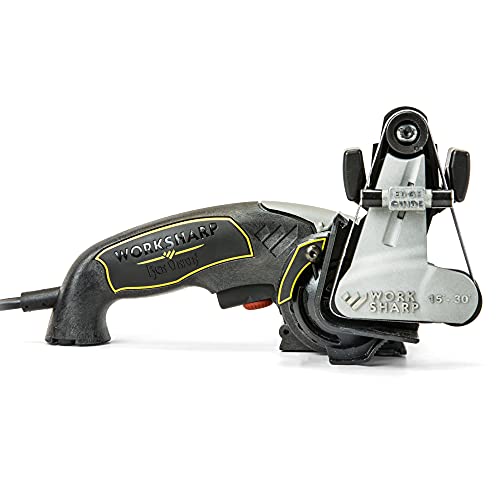
Having a sharp one-edged knife is essential for any cook or outdoors enthusiast. A sharp knife not only makes your tasks easier but also ensures safety in the kitchen or outdoors. Over time, one-edged knives can become dull and less effective, making it necessary to sharpen them.
Sharpening a one-edged knife might seem like a daunting task, but with the right technique and tools, it can be a simple and rewarding experience. In this article, we will guide you through the process of sharpening a one-edged knife, step by step.
Before we begin, it is important to mention that there are various methods to sharpen a one-edged knife. In this guide, we will be focusing on one of the most common and effective methods – using a sharpening stone. So, let’s get started and bring back the sharpness to your one-edged knife!
Tips for Sharpening One Edged Knife
Sharpening a one-edged knife is an essential skill every cook should possess. A sharp knife not only makes food preparation more efficient but also ensures safety in the kitchen. Here are some tips on how to sharpen a one-edged knife effectively:
1. Choose the right sharpening tool: There are various sharpening tools available, such as whetstones, honing rods, and electric sharpeners. Select a tool that suits your proficiency level and the condition of your knife.
2. Know the knife’s angle: One-edged knives usually have a bevel angle between 20-25 degrees. It’s crucial to maintain this angle while sharpening. You can use an angle guide or markings on the knife to help you achieve the correct angle.
3. Start with coarse grit: If your knife is blunt or has visible nicks, start sharpening with a coarse grit stone. Hold the knife at the correct angle and move it across the stone in a circular motion. Repeat this process on both sides of the blade.
4. Progress to finer grit: Once the blade has been sharpened using the coarse grit, switch to a finer grit stone to refine the edge. Repeat the sharpening process, gradually increasing the grit until you achieve the desired sharpness.
5. Hone the edge regularly: To maintain the sharpness of your knife, it’s essential to hone the edge regularly. Use a honing rod or a fine grit stone and gently run the knife along the rod or stone at the correct angle.
6. Test the sharpness: After sharpening, test the sharpness of the knife by slicing through a tomato or a piece of paper. A sharp knife should effortlessly cut through without squishing or tearing.
7. Practice proper knife techniques: Sharpening your knife is just one aspect of knife maintenance. It’s equally important to use your knife correctly, such as using a cutting board and avoiding excessive force, to prevent dulling the blade.
By following these tips, you can ensure that your one-edged knife remains sharp and ready for any culinary challenge. Remember, a sharp knife is a chef’s best friend!
Step-by-Step Guide for Sharpening a One Edged Knife
Sharpening a one edged knife is an essential skill that every kitchen enthusiast should possess. A properly sharpened knife not only enhances your culinary experience but also minimizes the risk of accidents. Follow these simple steps to sharpen your one edged knife effectively:
|
Step 1: Gather the necessary tools Before you begin sharpening your knife, make sure you have the following tools on hand:
Having these tools ready will ensure a smooth and efficient sharpening process. |
|
Step 2: Prepare the sharpening stone Wet the sharpening stone with water and place it on a stable surface. The water acts as a lubricant, making it easier to sharpen the knife. |
|
Step 3: Apply honing oil Apply a few drops of honing oil on the surface of the sharpening stone. This oil helps facilitate the sharpening process. |
|
Step 4: Position the knife Hold the knife firmly by the handle and position the edge against the stone at a 20-degree angle. |
|
Step 5: Start sharpening Using light pressure, slide the blade across the stone in a sweeping motion. Begin at the base of the blade and move towards the tip, maintaining a consistent angle. |
|
Step 6: Repeat the process Continue sharpening the knife by repeating the sweeping motion on both sides of the blade. Remember to maintain the 20-degree angle and apply consistent pressure. |
|
Step 7: Test the sharpness Once you are satisfied with the sharpness, carefully wipe off any remaining oil from the blade with a cloth or towel. Test the knife’s sharpness by slicing through a piece of paper or a ripe tomato. |
|
Step 8: Aftercare Properly clean and dry the sharpening stone and store it in a safe place. Maintaining the sharpness of your knife requires regular honing and occasional sharpening. |
By following these steps, you can effectively sharpen your one edged knife and ensure its optimum performance in the kitchen. Remember to exercise caution while handling a sharp knife and always prioritize your safety.
Common Mistakes to Avoid While Sharpening a One Edged Knife
When sharpening a one-edged knife, there are several common mistakes that should be avoided to ensure a proper and effective sharpening process. These mistakes can lead to subpar results and even damage the knife.
1. Using the wrong angle
One of the most common mistakes when sharpening a one-edged knife is using the wrong angle. Each knife is designed to be sharpened at a specific angle, and using a different angle can result in an uneven edge or even ruin the knife. It is important to research and understand the correct angle for your particular knife before sharpening.
2. Applying too much pressure
Applying too much pressure while sharpening can also be a common mistake. The goal is to remove a small amount of material from the blade to create a sharper edge, but applying excessive pressure can remove too much material and damage the blade. It is important to use a gentle and controlled motion when sharpening to avoid this mistake.
| Mistake | Consequence |
|---|---|
| Using the wrong angle | Uneven edge or knife damage |
| Applying too much pressure | Excessive material removal and blade damage |
| Ignoring the knife’s condition | Sharpening a dull or damaged knife |
| Not using the right sharpening tools | Ineffective sharpening and potential knife damage |
3. Ignoring the knife’s condition
Sharpening a knife that is already dull or damaged is another common mistake. If a knife has nicks or chips, it is important to address those issues before attempting to sharpen. Ignoring the knife’s condition and proceeding with sharpening can lead to ineffective results and potentially further damage the knife.
4. Not using the right sharpening tools
Using the wrong sharpening tools can also be a common mistake. Different knives require different sharpening tools, such as whetstones or honing rods. Using the wrong tool can result in ineffective sharpening and potentially damage the knife. It is essential to use the appropriate sharpening tool for the specific type of knife being sharpened.
By avoiding these common mistakes while sharpening a one-edged knife, you can ensure a successful sharpening process that results in a sharp and effective blade.
Tools and Materials Needed for Sharpening a One Edged Knife
To effectively sharpen a one edged knife, you will need the following tools and materials:
- A sharpening stone or whetstone
- A lubricant, such as water or honing oil
- A small bowl or container to hold the lubricant
- A towel or cloth for cleaning the knife
- A honing guide (optional, but recommended for beginners)
- A knife sharpening angle guide (optional)
- A leather strop (optional, for final polishing)
The sharpening stone or whetstone is the most essential tool for sharpening a one edged knife. Choose a stone with a grit suitable for your knife, typically between 1000 and 3000 grit. Higher grit stones produce a finer edge, while lower grit stones are more aggressive and remove material more quickly.
Using a lubricant, such as water or honing oil, is important to prevent the knife from overheating and to enhance the sharpening process. Water is commonly used for ceramic stones, while honing oil is recommended for natural or synthetic stones. Make sure to use the lubricant as instructed by the stone manufacturer.
A small bowl or container is useful for holding the lubricant during the sharpening process. This allows you to easily dip the stone and apply the lubricant as needed.
A towel or cloth is necessary for cleaning the knife before and after sharpening. This helps remove any dirt or debris that may interfere with the sharpening process and ensures a clean, smooth edge.
A honing guide is an optional but helpful tool, especially for beginners. It helps maintain a consistent angle while sharpening, ensuring an even edge across the entire length of the knife.
A knife sharpening angle guide is another optional tool that can be used to achieve a specific sharpening angle. It attaches to the spine of the knife and serves as a guide for positioning the knife on the sharpening stone.
A leather strop is a final optional tool that can be used for polishing the knife after sharpening. It helps remove any burrs or imperfections on the edge, resulting in an even sharper and more refined edge.
By having these tools and materials ready, you will be well-prepared to sharpen your one edged knife effectively and efficiently.










